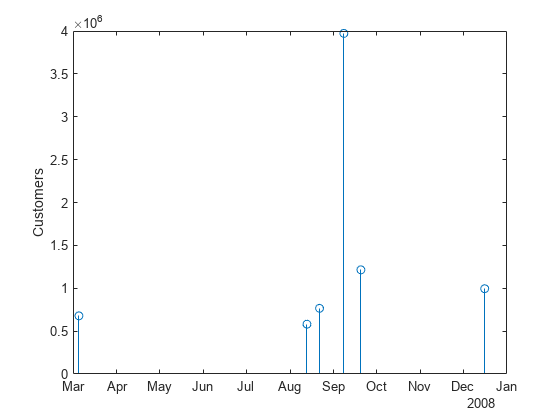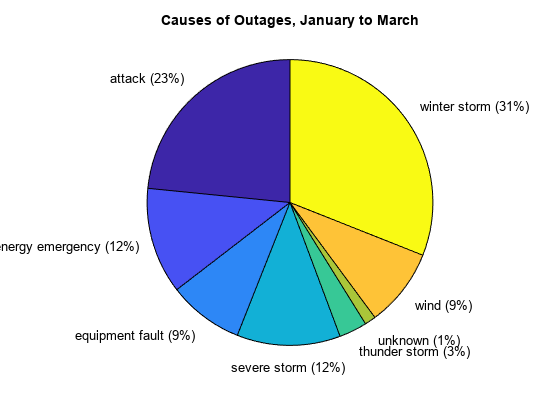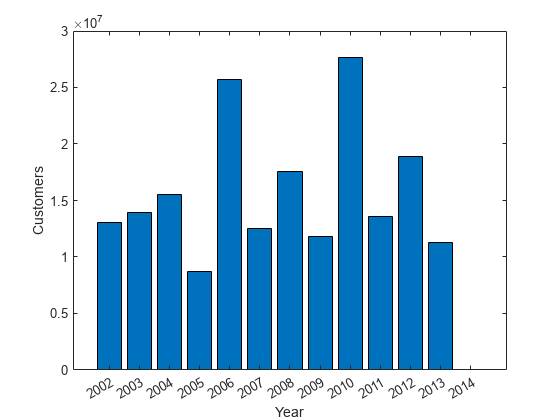在时间表中选择时间
时间表是一种表类型,用于将时间与每一行进行关联。您可以通过几种方式选择基于时间的数据子集:
使用
timerange或withtol函数查找特定范围内的时间。使用
datetime数组的分量匹配重复出现的时间单位,如天或月。使用
retime函数对数据进行重采样或分组。
例如,读取示例文件 outages.csv,其中包含 2002 年至 2014 年美国电力中断的数据。行时间向量 OutageTime 表示电力中断发生的时间。readtimetable 函数将其作为 datetime 数组导入。显示前五行。
TT = readtimetable('outages.csv');
head(TT,5) OutageTime Region Loss Customers RestorationTime Cause
________________ _____________ ______ __________ ________________ ___________________
2002-02-01 12:18 {'SouthWest'} 458.98 1.8202e+06 2002-02-07 16:50 {'winter storm' }
2003-01-23 00:49 {'SouthEast'} 530.14 2.1204e+05 NaT {'winter storm' }
2003-02-07 21:15 {'SouthEast'} 289.4 1.4294e+05 2003-02-17 08:14 {'winter storm' }
2004-04-06 05:44 {'West' } 434.81 3.4037e+05 2004-04-06 06:10 {'equipment fault'}
2002-03-16 06:18 {'MidWest' } 186.44 2.1275e+05 2002-03-18 23:23 {'severe storm' }
在 R2019a 之前,使用 readtable 读取表数据并使用 table2timetable 将其转换为时间表。
选择时间范围
要查找特定范围内的数据,您可以使用 timerange 函数,该函数定义基于时间的下标来进行索引。例如,定义 2008 年夏季,也就是从 6 月 20 日开始到 9 月 21 日结束,的范围。默认情况下,timerange 定义半开区间,左边关闭,右边打开,因此将结束日期指定为 9 月 22 日。
TR = timerange("2008-06-20","2008-09-22")
TR = timetable timerange subscript: Select timetable rows with times in the half-open interval: Starting at, including: 20-Jun-2008 00:00:00 Ending at, but excluding: 22-Sep-2008 00:00:00 See Select Times in Timetable.
找出在该范围内发生的电力中断,然后对受影响的客户数量绘制随时间变化的图。
summer08 = TT(TR,:);
stem(summer08.OutageTime,summer08.Customers)
ylabel("Customers")
在此时间范围内的几次电力中断对客户产生很大影响。将范围扩大到 2008 年全年,并寻找类似的高值数字。
TR = timerange("2008","years"); all08 = TT(TR,:); high08 = all08(all08.Customers > 500000,:); stem(high08.OutageTime,high08.Customers) ylabel('Customers')

timerange 函数也有助于选择特定日期。通过比较 datetime 值来选择时间可能会产生错误结果,因为所有 datetime 值都包含日期和时间分量。但是,当您仅指定 datetime 值的日期分量时,时间分量将设置为午夜。因此,虽然存在从 6 月 26 日以来的数据,但像这样的比较不会返回结果。
any(summer08.OutageTime == datetime("2008-06-26"))ans = logical
0
您可以改用 timerange。
TR = timerange("2008-06-26","days"); june26 = summer08(TR,:)
june26=1×5 timetable
OutageTime Region Loss Customers RestorationTime Cause
________________ _____________ ______ _________ ________________ _________________
2008-06-26 22:36 {'NorthEast'} 425.21 93612 2008-06-27 06:53 {'thunder storm'}
定义范围的另一种方法是使用 withtol 指定一段时间内的容差。例如,查找从 2008 年夏天以来的行,其中 OutageTime 在 9 月 1 日劳动节的三天内。
WT = withtol("2008-09-01",days(3));
nearSep1 = summer08(WT,:)nearSep1=4×5 timetable
OutageTime Region Loss Customers RestorationTime Cause
________________ _____________ ______ _________ ________________ ___________________
2008-09-01 23:35 {'SouthEast'} 206.27 2.27e+05 NaT {'equipment fault'}
2008-09-01 00:18 {'MidWest' } 510.05 74213 2008-09-01 14:07 {'thunder storm' }
2008-09-02 19:01 {'MidWest' } NaN 2.215e+05 2008-09-03 02:58 {'severe storm' }
2008-08-29 20:25 {'West' } NaN 31624 2008-09-01 01:51 {'wind' }
匹配时间单位
您还可以使用 datetime 值的单位(如小时或天)来标识用于逻辑索引的行。这种方法对于指定周期性间隔很有用。
例如,查找 OutageTime 的值,其月份分量的值等于或小于 3,对应于每年的 1 月、2 月和 3 月。使用生成的逻辑数组对 TT 进行索引。
TR = (month(TT.OutageTime) <= 3); winterTT = TT(TR,:); head(winterTT,5)
OutageTime Region Loss Customers RestorationTime Cause
________________ _____________ ______ __________ ________________ ________________
2002-02-01 12:18 {'SouthWest'} 458.98 1.8202e+06 2002-02-07 16:50 {'winter storm'}
2003-01-23 00:49 {'SouthEast'} 530.14 2.1204e+05 NaT {'winter storm'}
2003-02-07 21:15 {'SouthEast'} 289.4 1.4294e+05 2003-02-17 08:14 {'winter storm'}
2002-03-16 06:18 {'MidWest' } 186.44 2.1275e+05 2002-03-18 23:23 {'severe storm'}
2005-02-04 08:18 {'MidWest' } NaN NaN 2005-02-04 19:51 {'attack' }
创建一个冬季时间原因的饼图。pie 函数只接受数值或 categorical 输入,因此首先将 Cause 转换为 categorical。
winterTT.Cause = categorical(winterTT.Cause);
pie(winterTT.Cause)
title("Causes of Outages, January to March");
按时间段分组
retime 函数通过对值进行重采样或分组来调整行时间,以创建指定的间隔。其预定义间隔从秒到年不等,您可以指定如何处理间隔的缺失值或多个值。例如,您可以选择每周的第一个观测值,或对一个季度的观测值进行计数。
对于电力中断数据,您可以使用 retime 来查找每年的总数。首先,创建一个只包含数值变量的时间表。然后,调用 retime 并指定年度间隔,用总和组合多个值。输出中每年对应一个行,包含该年的总损失和受影响的客户总数。
numTT = TT(:,vartype("numeric")); numTT = retime(numTT,"yearly","sum"); head(numTT,5)
OutageTime Loss Customers
________________ _____ __________
2002-01-01 00:00 81335 1.3052e+07
2003-01-01 00:00 58036 1.396e+07
2004-01-01 00:00 51014 1.5523e+07
2005-01-01 00:00 33980 8.7334e+06
2006-01-01 00:00 35129 2.5729e+07
创建一个条形图,显示每年受影响的客户数量。
bar(numTT.OutageTime,numTT.Customers) xlabel("Year") ylabel("Customers")

使用行时间计算持续时间
您可以将时间表的行时间与其他 datetime 或 duration 值结合使用来执行计算。例如,计算电力中断数据中列出的停电持续时间。然后计算每月电力中断持续时间的中位数并对其绘图。
首先,通过从 RestorationTime(即停电结束时间)中减去行时间(即停电开始时间),将电力中断持续时间添加到 TT。更改 OutageDuration 的格式,以天为单位显示电力中断的持续时间。显示 TT 的前五行。
TT.OutageDuration = TT.RestorationTime - TT.OutageTime;
TT.OutageDuration.Format = 'd';
head(TT,5) OutageTime Region Loss Customers RestorationTime Cause OutageDuration
________________ _____________ ______ __________ ________________ ___________________ ______________
2002-02-01 12:18 {'SouthWest'} 458.98 1.8202e+06 2002-02-07 16:50 {'winter storm' } 6.1889 days
2003-01-23 00:49 {'SouthEast'} 530.14 2.1204e+05 NaT {'winter storm' } NaN days
2003-02-07 21:15 {'SouthEast'} 289.4 1.4294e+05 2003-02-17 08:14 {'winter storm' } 9.4576 days
2004-04-06 05:44 {'West' } 434.81 3.4037e+05 2004-04-06 06:10 {'equipment fault'} 0.018056 days
2002-03-16 06:18 {'MidWest' } 186.44 2.1275e+05 2002-03-18 23:23 {'severe storm' } 2.7118 days
创建一个只包含电力中断持续时间的时间表。TT 中某些行的停电结束时间为缺失值 NaT,导致 OutageDuration 中出现 NaN 值。要从 medianTT 中删除 NaN 值,请使用 rmmissing 函数。然后使用 retime 计算每月电力中断持续时间中位数。显示 medianTT 的前五行。
medianTT = TT(:,"OutageDuration"); medianTT = rmmissing(medianTT); medianTT = retime(medianTT,'monthly',@median); head(medianTT,5)
OutageTime OutageDuration
________________ ______________
2002-02-01 00:00 6.1889 days
2002-03-01 00:00 2.7472 days
2002-04-01 00:00 NaN days
2002-05-01 00:00 0.72917 days
2002-06-01 00:00 0.22431 days
创建每月电力中断持续时间中位数的阶梯图。
stairs(medianTT.OutageTime,medianTT.OutageDuration) xlabel("Year") ylabel("Median Duration (days)")

另请参阅
categorical | timetable | retime | timerange | readtimetable | month | withtol | rmmissing | vartype | datetime | duration | NaT